Watching a healthy school of fish freely swimming in your fish tanks must be a relaxing and exciting experience for every ornamental fish hobbyist. Using fresh water during the cleaning process is crucial to ensure the health of your fish. Taking care of these colorful pets demands a high level of cleanliness and meticulous care […]
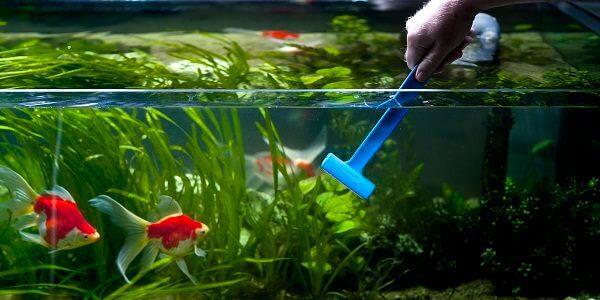
Watching a healthy school of fish freely swimming in your fish tanks must be a relaxing and exciting experience for every ornamental fish hobbyist. Using fresh water during the cleaning process is crucial to ensure the health of your fish. Taking care of these colorful pets demands a high level of cleanliness and meticulous care unless they may become ill and die soon. If you are a beginner and have never cleaned the water tank before, this topic is useful for you. Cleaning a fish tank should not focus on the quality of the water inside the tank only, there are several details that need your regular check. Cleaning experts from Sparkling and Beyond have listed everything you need to know about how to clean fish tank, as well as how to clean a fish tank filter and how to clean a fish tank glass.
Depending on the size of the water tank and the number of your fish, here are some tools and devices you’ll need:
Appliance and tools:
For saltwater tanks, it is crucial to use a powerhead and heater to maintain the appropriate environment for live coral fish.
Replacing water: You should prepare an amount of water which is equal to 20 – 30% of your tank’s volume.
When replacing water, ensure the new water matches the aquarium’s temperature by adding a small amount of warm water to avoid shocking the fish.
Before you clean the fish tank, remember to unplug all the electrical devices and remove all of them along with all the ornaments apart from the living plants. To save microorganisms, which are necessary for the fish tank, living inside the filter, soak the filter in a bucket of water that you get from the fish tank.
It is crucial to clean the tank walls to maintain an unobstructed view of the fish. Use an algae scraper for this task, and handle different materials carefully to avoid scratching.
Important: Removing things slowly so that you won’t stir any dregs on the bottom of the tank. Managing waste tank water carefully during the cleaning process is essential to maintain water quality and prevent overflow. This helps in removing fish waste and ensuring proper filtration without harming the fish.
Algae is the most basic life form on earth that only needs water and light for living. It can bloom anywhere on the surface as well as the light is available. Cleaning the tank walls is crucial to prevent algae buildup and maintain an unobstructed view of your fish.
**So,**how to clean a fish tank glass?
Tip: There is a kind of magnetic algae cleaner which has two pieces of contrary magnets with a soft felt covering. Placing one magnet on the inside of the aquarium, and another on the outside of the aquarium. One magnet is attracted by another so when you move the outer magnet, the inner one will move parallelly and clean the algae. Magnetic algae works better for the glass tank.
If the pad or scraper can not remove all the dirt, use a plastic blade to remove the remaining algae (especially for an acrylic aquarium) so that it won’t scratch your tank.
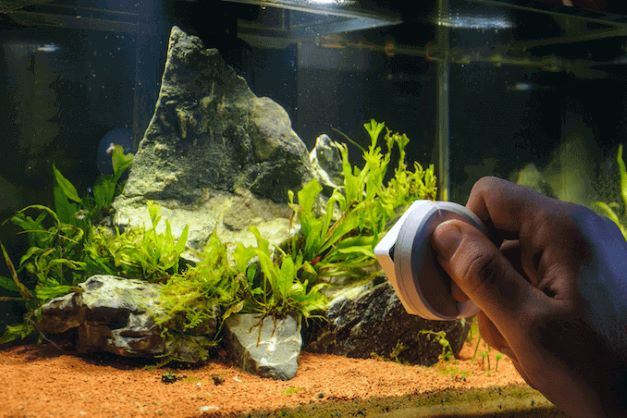
Magnetic algae cleaner (Source: Internet)
Using a siphon to vacuum the debris from the bottom of the tank. There are a lot of siphon designs in the pet shop but remember to choose a siphon which can function to remove debris not the gravel or sand.
It is crucial to manage waste tank water carefully during the cleaning process to maintain water quality and prevent overflow. Proper handling of waste tank water helps in removing fish waste and ensures effective filtration without harming the fish.
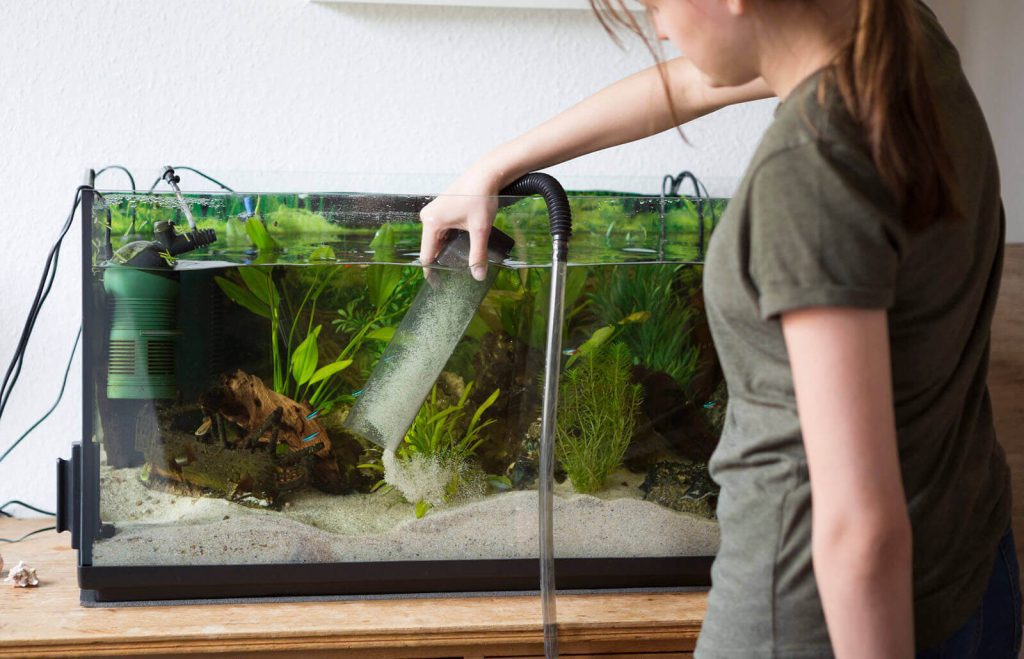
Siphon to vacuum the debris (Source: Internet)
As we mentioned, if you have fake grass and some plastic or stone decoration, move it out of the tank, they will have separate cleaning.
It is important to clean the tank walls to maintain an unobstructed view of the fish. Use an algae scraper for this task, handling different materials carefully to avoid scratches.
To clean fish tank glass and clean fish tank decoration, you can use an algae scraper and soap it with a little bleach. Then, wash again with clean water and air dry before putting them back into the aquarium.
No matter the quality and the type of the filter you are using, clean it and change the medium sometimes in your water filter. Let’s follow how to clean a fish tank filter as below.
Sponge filter is the most preferable filter as it is easy to use, change and the price is reasonable. Having removed it out of the tank, you should rinse this filter by the water that is contained in the tank (that you store in the bucket). Doing this will help the filter to remove dirt but does not kill the beneficial bacteria building up inside it.
For some kinds of filter which contain carbon, ammonia absorbers, or ion-exchange resins it will need replacing every couple of weeks because it will no longer be able to absorb materials.
Finally, clean other parts of the tank, such as tubing, the exterior of the tank,… and return it to the tank as quickly as possible to avoid losing the bacteria colonies.
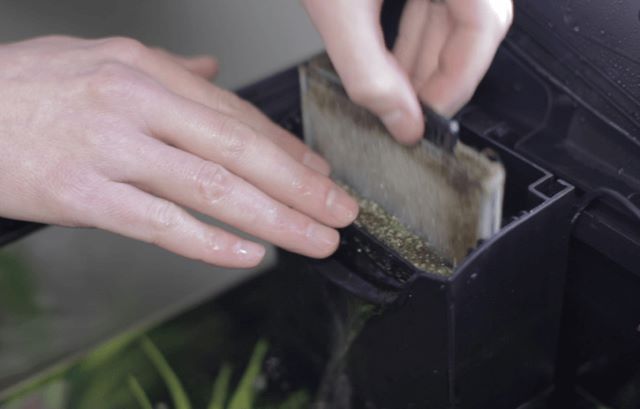
Clean the filter (Source: Internet)
Replacing fish tank water does not mean you will replace the whole amount of water inside. It is crucial to use fresh water during the replacement process to ensure a healthy environment for your fish. As you prepared replacing water previously, check the temperature of that water before adding it into the tank. Make the temperature the same as the remaining water inside the tank so that it won’t affect your fish. Adding a small amount of warm water can help achieve the desired temperature for tropical tanks, maintaining a stable environment during routine water changes.
Maintaining good water quality is essential for the health and well-being of your fish. Regular water changes, monitoring water parameters, and testing water quality are crucial steps in keeping your fish tank clean and healthy. By ensuring optimal water conditions, you can create a thriving environment for your aquatic pets.
Testing water quality is a crucial step in maintaining a healthy fish tank. Regular testing helps you ensure that the water is safe for your fish. You can use a water test kit to check for parameters such as ammonia, nitrite, and nitrate levels. These kits are available at most pet stores and are easy to use. By keeping an eye on these levels, you can prevent harmful conditions that could affect your fish’s health.
Monitoring water parameters is essential to ensure that your fish tank remains a healthy environment. Regularly check the water temperature, pH, and hardness. Use a thermometer to monitor the water temperature, ensuring it stays within the ideal range for your fish species. A pH test kit will help you keep track of the pH level, which should be stable and suitable for your fish. Additionally, check the water hardness, as it can impact the health of your fish. Consistent monitoring helps you catch any issues early and maintain a stable environment.
The regularity of cleaning and water changes will entirely depend on the size of your tank, and the amount of fish you have in there. Out of this, you need to check the status of your aquarium usually, in case there is any “strange visitor” appearing. If they come, it is time to clean it, too.
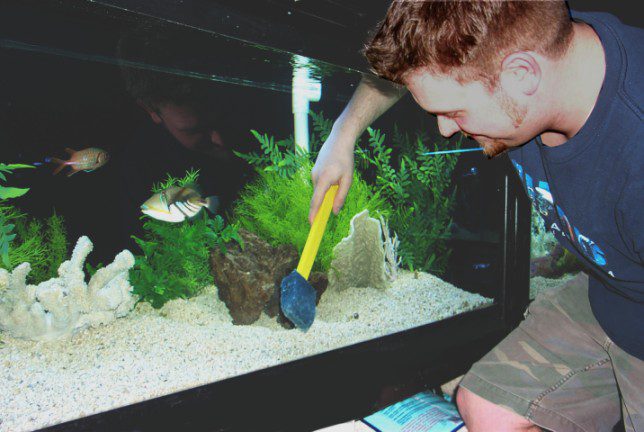
Cleaning a fish tank (Source: Internet)
Regular water changes are vital to maintaining good water quality. Aim to change 10-20% of the tank water every week, depending on the size of your tank and the number of fish you have. Use a gravel vacuum to remove debris and fish waste from the substrate, ensuring a clean environment for your fish. When replacing the old water, use fresh, dechlorinated water. It’s important to match the temperature of the new water to the same temperature as the tank water to avoid stressing your fish.
Avoid removing more than 50% of the tank water at once, as this can cause a sudden change in water parameters and stress your fish. Instead of using tap water directly from the tap, which may contain harmful chlorine and chloramine, use a water conditioner to make the water safe for your fish. By following these steps, you can maintain good water quality and keep your fish healthy and thriving. Remember to always test your water quality regularly, monitor water parameters, and perform regular water changes to keep your fish tank clean and healthy.
Breeding a fish takes more time and effort than taking care of a dog or a cat since the underwater biodiversity is vulnerable and easily killed by a minor change in the environment so cleaning a fish tank has never been a one-step process. Water partially changing won’t harm the microorganisms inside, which are essential for your aquarium.
With the mission of helping people to have work-life balance, we encourage our customers to enjoy their lives and let us take care of their house cleanliness. We have collected a range of tips and provide House Cleaning Service. Contact us immediately, experienced staff of Sparkling and Beyond are waiting for you!

As the admin of Sparkling & Beyond, I bring a wealth of knowledge and passion for excellence in the cleaning industry. With years of experience in providing top-notch cleaning solutions, I am dedicated to sharing valuable insights and tips to help maintain pristine and healthy living environments. My mission is to ensure every home and office we service sparkles with cleanliness and comfort.
![]()